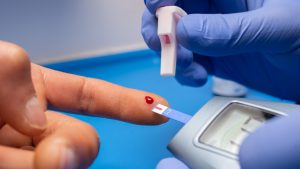Receiving a diabetes diagnosis can be overwhelming, but it’s essential to remember that it doesn’t have to become an insurmountable obstacle. Diabetes, especially type 1, may seem like a daily challenge, but it can also be the driving force needed to achieve your goals. This is the inspiring testimony of a collegiate athlete who, despite her diagnosis, has proven that with determination, education, and support, it is possible to live fully and succeed.
The Diagnosis: A New Beginning
It was in eighth grade when the diagnosis came: type 1 diabetes. Confusion and fear are common reactions upon receiving such news. Constant thirst, fatigue, and the sense that something was wrong marked the start of a new life. At that moment, our story’s protagonist felt alone, as she didn’t know anyone with the same condition. However, the key to facing this challenge was developing a consistent schedule with her doctors and following an appropriate treatment plan.
Access to technology, such as insulin pumps and continuous glucose monitors, allowed her to learn about her condition and adapt her life to her body’s needs. This is crucial for anyone living with diabetes: knowledge and education are powerful tools.
A Passion for Sports
Upon receiving her diagnosis, one of the first concerns for our athlete was whether she could continue running track. Her father’s support was vital in this process. With her doctor’s guidance, she not only managed to return to running but exceeded her expectations, improving her performance and setting increasingly ambitious goals.
This reminds us that a diabetes diagnosis doesn’t mean we have to give up our passions. On the contrary, it can motivate us to be more disciplined and strive for excellence. Planning and preparation become essential skills, not just in sports, but in all aspects of life.
Maintaining Balance
Living with diabetes involves a series of daily responsibilities. From following a balanced diet to counting carbohydrates and managing insulin correctly, every aspect of life requires attention. However, while it may seem overwhelming, it is entirely manageable. The key is to find a system that works for you and allows you to lead an active, healthy life.
It’s vital to recognize that while there are no days off when living with diabetes, this doesn’t mean we should give up on our dreams. Discipline in managing diabetes can translate into discipline in other areas of life, such as sports and studies.
The Power of Support
One of the most important lessons our athlete has learned is the value of having a support system. She is grateful to her parents, teammates, coaches, and trainers for always being by her side. This support is not just emotional; it also provides motivation and encouragement during tough times.
Diabetes can feel like a lonely journey, but it doesn’t have to be. Sharing experiences with others who are in the same situation can offer comfort and new perspectives. Support communities, both online and in-person, are valuable resources for learning and sharing management strategies.
A Message of Hope
This athlete’s testimony is a powerful reminder that a diabetes diagnosis is not the end of your dreams, but rather a new chapter in your personal story. With the right attitude, an effective management plan, and a strong support system, it is possible to live fully and achieve all your goals.
Type 1 diabetes is just one part of life; it does not define who you are or what you can accomplish. With effort and determination, living with diabetes can be an enriching and empowering experience. So, if you find yourself in a similar situation, remember: living with diabetes will not stop you. On the contrary, it can propel you to be stronger and braver than ever.

Type 2 Diabetes: Is It Really Reversible?
A recent National Geographic article [link] explores how type 2 diabetes could be reversible with the right approaches. This condition, which affects millions of people worldwide, has long been considered a chronic and progressive disease. However, recent research challenges this perception and suggests that with lifestyle changes and the right approach, remission is possible. The

How Do GLP-1 Drugs Compare? A Breakdown of Ozempic, Mounjaro, and Trulicity
GLP-1 receptor agonists have revolutionized diabetes management, with drugs like Ozempic, Mounjaro, and Trulicity leading the market. But how do these medications compare in terms of effectiveness, side effects, and patient outcomes? Let’s explore their differences and what they mean for diabetes patients. Understanding GLP-1 Medications GLP-1 receptor agonists mimic a natural hormone that helps

Why Has Medicare Spending on Diabetes Medications Skyrocketed in 5 Years?
In the past five years, Medicare spending on diabetes medications has increased nearly fivefold, reaching $35.8 billion in 2023. This surge has been primarily driven by the growing use of GLP-1 drugs such as Ozempic, Mounjaro, and Trulicity. But what is behind this cost escalation, and how does it affect patients and the U.S. healthcare

The Gut Microbiota and Blood Sugar Control: A Hidden Connection
The human gut is home to trillions of bacteria that play a crucial role in digestion, immune function, and even metabolism. Recent research has revealed a fascinating link between the gut microbiota and blood sugar regulation, shedding light on how the balance of microbes in our intestines can influence diabetes risk and overall metabolic health.

The Dawn Phenomenon: Why Blood Sugar Rises While You Sleep
For many people with diabetes, waking up with high blood sugar levels can be frustrating—especially if they didn’t eat anything overnight. This early-morning spike in blood glucose is known as the Dawn Phenomenon, and it happens due to natural hormonal changes in the body. But why does it occur, and how can it be managed?

The Influence of Red Light on Blood: Can It Improve Diabetes?
Type 2 diabetes is a metabolic disease characterized by insulin resistance and elevated blood glucose levels. In the search for complementary alternatives to improve glycemic control, red light therapy has gained attention due to its potential to enhance circulation, reduce inflammation, and optimize cellular function. But what does science say about it? ✨ What is

